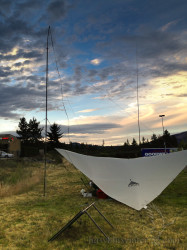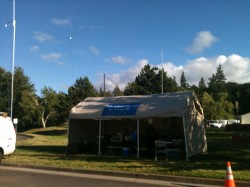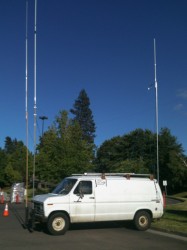 Since last year’s Field Day, I’ve upgraded my amateur radio license to General Class, but still haven’t spent any time on the air. Instead, I’ve been using my amateur radio privileges to down-link wireless video from remote control airplanes, so all is not lost. Field day is a great opportunity to get on the air and work the HF bands, making remote, long distance contacts from off-the-grid power and field conditions. Another great incentive for attending field day is conversing with other amateur radio operators (HAMs) about a variety of interesting and geeky topics. I end up learning a ton about amateur radio and other technical fields, so it’s always well worth the investment of time and sleep deprivation.
Since last year’s Field Day, I’ve upgraded my amateur radio license to General Class, but still haven’t spent any time on the air. Instead, I’ve been using my amateur radio privileges to down-link wireless video from remote control airplanes, so all is not lost. Field day is a great opportunity to get on the air and work the HF bands, making remote, long distance contacts from off-the-grid power and field conditions. Another great incentive for attending field day is conversing with other amateur radio operators (HAMs) about a variety of interesting and geeky topics. I end up learning a ton about amateur radio and other technical fields, so it’s always well worth the investment of time and sleep deprivation.
Immediately after arriving, I ran into another first person view (FPV) hobbyist who is also a HAM. He had a small quad copter with a wireless camera and we spent about an hour flying this little bird with down-linked video. Though it was small, it performed admirably in the wind. When the quadcopter’s battery finally died, he brought out his 20 meter mobile rig and used a slingshot with a fishing reel to string an antenna through an overhead treebranch. With so many amateurs competing in the field day contest, it wasn’t long before he made two contacts, one in Manitoba, Canada and another in Nevada. His entire mobile rig was easily transported in a hard briefcase and powered by a couple lithium polymer batteries, originally intended for powering remote control aircraft. I can definitely see myself with a similar rig, making contacts while camping on a remote mountain top.
As the sun set, we got down to business: eating junk food and talking about technical stuff. While there was a radio contest going on, we were too engrossed in our conversation about robotics, Linux, nanotechnology, processor design, etc. that we let hours pass before we finally sat down at the stations to begin DXing. I lasted until about 5AM after which my fatigue level left me mostly zombified. Every time I’m determined to pull an all-nighter with ease (like I did many times in college), I’m left disappointed and exhausted. I must be getting old! :(
Hopefully by this time next year I will have purchased my first HF radio and made some non-field day DX contacts. Time will tell.









